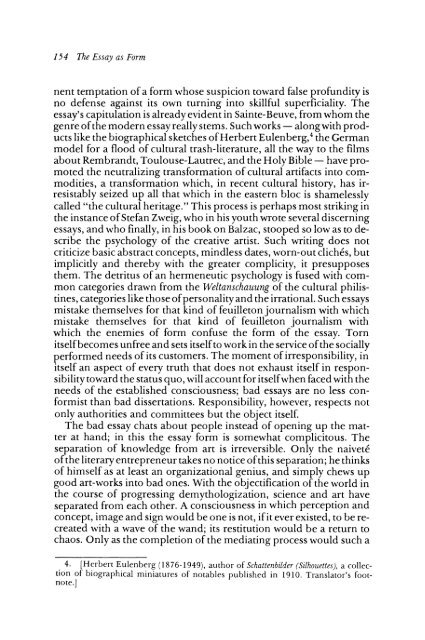Adorno-The-Essay-As-Form
Adorno-The-Essay-As-Form
Adorno-The-Essay-As-Form
You also want an ePaper? Increase the reach of your titles
YUMPU automatically turns print PDFs into web optimized ePapers that Google loves.
154 <strong>The</strong> <strong>Essay</strong>as <strong>Form</strong>nent temptation of a form whose suspicion toward false profundity isno defense against its own turning into skillful superficiality. <strong>The</strong>essay's capitulation is already evident in Sainte-Beuve, from whom thegenre of the modern essay really stems. Such works -alongwith productslike the biographical sketches of Herbert E~lenberg,~ the Germanmodel for a flood of cultural trash-literature, all the way to the filmsabout Rembrandt, Toulouse-Lautrec, and the Holy Bible - have promotedthe neutralizing transformation of cultural artifacts into commodities,a transformation which, in recent cultural history, has irresistablyseized up all that which in the eastern bloc is shamelesslycalled "the cultural heritage." This process is perhaps most striking inthe instance of Stefan Zweig, who in his youth wrote several discerningessays, and who finally, in his book on Balzac, stooped so low as to describethe psychology of the creative artist. Such writing does notcriticize basic abstract concepts, mindless dates, worn-out clich6s, butimplicitly and thereby with the greater complicity, it presupposesthem. <strong>The</strong> detritus of an hermeneutic psychology is fused with commoncategories drawn from the Weltanschauung of the cultural philistines,categories like those of personality and the irrational. Such essaysmistake themselves for that kind of feuilleton journalism with whichmistake themselves for that kind of feuilleton journalism withwhich the enemies of form confuse the form of the essay. Tornitself becomes unfree and sets itself to work in the service of the sociallyperformed needs of its customers. <strong>The</strong> moment of irresponsibility, initself an aspect of every truth that does not exhaust itself in responsibilitytoward the status quo, will account for itselfwhen faced with theneeds of the established consciousness; bad essays are no less conformistthan bad dissertations. Responsibility, however, respects notonly authorities and committees but the object itself.<strong>The</strong> bad essay chats about people instead of opening up the matterat hand; in this the essay form is somewhat complicitous. <strong>The</strong>separation of knowledge from art is irreversible. Only the naivetCof the literary entrepreneur takes no notice of this separation; he thinksof himself as at least an organizational genius, and simply chews upgood art-works into bad ones. With the objectification of the world inthe course of progressing demythologization, science and art haveseparated from each other. A consciousness in which perception andconcept, image and sign would be one is not, if it ever existed, to be recreatedwith a wave of the wand; its restitution would be a return tochaos. Only as the completion of the mediating process would such a4. [Herbert Eulenberg (1 876-1949), author of Schattenbilder (Silhouettes), a collectionof biograptlical miniatures of notables published in 1910. Translator's footnote.]


